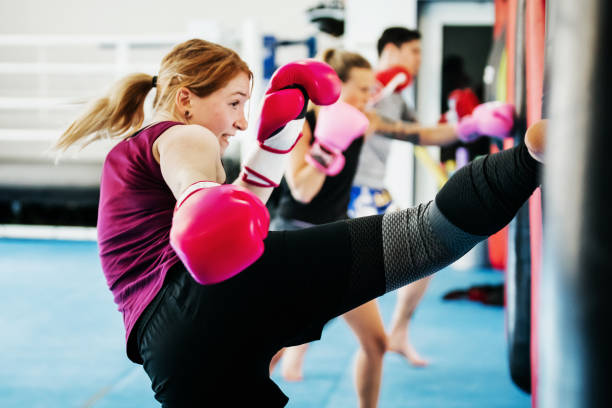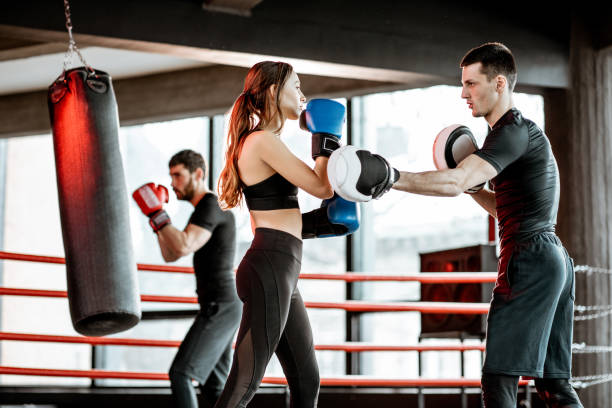
A group of amateur kickboxers practicing drills together and shadow boxing at their local gym.
Boxing’s not like running on a treadmill. You don’t just move — you fight gravity, time, and yourself. Every punch burns, but that’s the point. When you’re a beginner, boxing feels clumsy at first — too many moving parts, too much to think about. But once it clicks, it’s addictive.
The rhythm of jabs and footwork builds something other workouts miss: grit. You’ll sweat, curse, maybe question your life choices after the first few rounds. But trust me, boxing exercises for beginners give you visible progress — not just muscle, but confidence.
Boxing training for beginners isn’t about fighting someone else. It’s about fighting that lazy version of yourself who’d rather scroll instead of move.
The Core Boxing Exercises for Beginners
Let’s start with the basics. The good stuff that actually works. Don’t jump into fancy combinations or YouTube tricks. Focus on fundamentals.
Jab. Cross. Hook. Uppercut. That’s your bread and butter. Drill them until they feel like second nature. Add in footwork — small steps, light on your toes. Imagine the ground’s hot. Move like it burns.
Shadowboxing might feel weird at first, like you’re pretending. But it’s the best mirror you’ll ever find. You see your form, your rhythm, your breathing. Ten minutes of shadowboxing with focus beats thirty minutes of sloppy bag work.
When you’re ready, bring in the heavy bag. Hit it like you mean it, but not like you’re trying to kill it. Aim for control, not chaos. A tired boxer with technique still wins over a wild one with power.
Warm Up Like You Mean It
Before you swing, you move. Warming up isn’t just for show — it’s injury prevention. Your shoulders, hips, and wrists take a beating in boxing. Give them a chance.
Start with jump rope. Not for fancy tricks — just get your heart pumping. Then throw in some arm circles, hip rotations, and shadow movement. Feel your body wake up.
And don’t skip stretching. Yeah, it feels slow, maybe boring. But flexibility is the secret sauce behind strong punches. Tight muscles punch weak. Loose muscles snap harder.

A good warm-up should leave you sweaty before you even hit the bag. That’s when you know you’re ready.
Conditioning — The Secret Weapon
Everyone loves to hit the bag. Few love conditioning. That’s where champions separate from dabblers.
Boxing conditioning is brutal — jump rope, burpees, pushups, planks, sprints. You’ll hate it, but you’ll need it. Every punch starts from your legs and ends in your lungs. Without cardio, your punches die in round one.
For beginners, keep it simple. Three rounds of jump rope, three of bag work, two of core. That’s enough to crush most folks early on.
And don’t forget recovery. Take a rest day. Eat right. Sleep more than you think you should. Your body needs time to adapt.
Why Form Beats Power Every Time
Beginners always want to hit harder. They throw wild, off-balance, with shoulders tense and faces scrunched. That’s how you gas out fast.
Real power comes from form — from your feet to your hips to your shoulders, all snapping in one motion. It’s not about muscle. It’s about timing and leverage.
Watch a pro hit the bag. It’s quiet. Controlled. Efficient. That’s what you want. Don’t chase chaos. Chase flow.
Film yourself sometimes. You’ll catch mistakes — dropping hands, leaning too far forward, elbows flaring. Fix those, and your power jumps instantly.
Choosing the Best Gloves for Boxing Training
Now let’s talk gloves. Everyone loves shiny new gear, but not all gloves are built equal.
For beginners, comfort and protection matter more than brand names. You need gloves that fit snug, support your wrists, and cushion your knuckles. 12 to 16 oz is your sweet spot depending on size and purpose. Heavier gloves build endurance; lighter ones sharpen speed.
Look for genuine leather or high-grade synthetic material. Cheap gloves die fast and stink worse than a gym towel. Brands like Everlast, Title, Ringside, or Hayabusa are solid.
And always — always — wrap your hands. Good gloves can’t save bad wraps. Protect your tools. You only get one pair.
Sparring — The Truth No One Tells You
Sparring looks fun on TV. In real life? It’s humbling. The first time someone tags you, your brain panics. You forget every combo you drilled.
That’s okay. Everyone goes through it. Sparring isn’t about winning. It’s about learning control, timing, and how to stay calm under fire.

Start slow. Find a good coach who matches you with someone patient. Go light. Focus on movement, not damage. If you can breathe and think while punches fly, you’re improving.
Respect the ring. Ego has no place there. The best boxers are the calmest ones.
Building a Home Boxing Setup
Can’t hit the gym every day? No problem. Set up a mini boxing zone at home.
Grab a freestanding heavy bag or double-end bag — something compact. You’ll also need a jump rope, gloves, wraps, and space to move.
A mirror helps too. Watching yourself hit and move keeps form tight. And if you’ve got a bit more budget, a reflex ball or resistance bands add variety.
Consistency beats fancy gear, though. You can build skill in your garage if you show up daily.
Mental Game — The Fighter’s Edge
Boxing’s 80% mental. The other 20%? Also mental.
When you’re exhausted, when your arms feel like lead, your brain starts lying. “Stop. Rest. You’ve done enough.” That’s when you decide what kind of fighter you are.
Beginners often underestimate how much boxing tests patience. You won’t master combos in a week. You’ll mess up. A lot. But every missed punch is a lesson.
Discipline beats motivation. Motivation fades when you’re sore. Discipline shows up anyway.
Remember why you started. Keep that reason close — maybe it’s fitness, maybe confidence, maybe stress relief. Whatever it is, use it.
Nutrition and Recovery for Boxers
You can’t out-train bad fuel. Boxing drains energy fast, and beginners burn more because they’re tense.
Eat clean. Real food. Lean proteins, veggies, carbs that come from the ground — not a box. Hydrate like it’s your job. Electrolytes matter too, especially after long sessions.
Post-training, stretch again. Maybe ice sore joints. Take care of your hands — they’re your tools.
Sleep at least seven hours. Recovery’s not a luxury; it’s part of training. You can’t fight tired.
Common Mistakes Beginners Make
Here’s the truth — most beginners make the same mistakes. You’ll probably make them too, and that’s fine. But here’s your heads-up.
They hit too hard, too early. They skip warm-ups. They forget defense. They focus on throwing, not moving.
And the biggest mistake? Quitting too soon. Boxing’s awkward at first. You’ll feel clumsy, slow, maybe even embarrassed. Stick through that stage. That’s when most people give up.
Progress sneaks up on you. One day you’ll realize your punches land sharper, your breathing’s calmer, your confidence higher. That’s the payoff.
How to Stay Consistent
The hardest fight’s not in the ring — it’s against your own excuses.
Set small goals. Don’t plan to “get fit.” Plan to train three times a week. Write it down. Keep it simple.
Find a community or coach. Accountability helps. And celebrate the little wins — mastering footwork, surviving a three-minute round without dying.

Remember, boxing’s not about perfection. It’s about persistence. You’ll miss days. That’s fine. Just don’t miss two.
Wrapping It Up — Your Next Move
If you’re reading this, you’ve already done the hardest part: deciding to start. Boxing training for beginners can look intimidating, but it’s just one punch, one round, one session at a time.
Get yourself the right gear — the best gloves for boxing training that protect and fit like they’re part of you. Focus on form before power. Stay humble, stay hungry. Boxing will change your body, sure. But it’ll change your mindset even more. You’ll carry that discipline into everything you do.
Ready to throw your first punch? Visit Be Happy Boxing and get started the right way. Learn, sweat, grow — and keep swinging.
FAQs About Boxing Exercises for Beginners
Q: What’s the best boxing exercise for beginners?
Shadowboxing. No gear needed, no pressure. It teaches coordination, timing, and rhythm — all the foundations you’ll need later.
Q: How often should beginners train boxing?
Start with two or three days a week. Let your body adapt. Add more when you can move without dying halfway through warm-ups.
Q: What weight gloves should beginners use?
Go with 12–16 oz depending on your size and training type. Heavier gloves build endurance; lighter ones help with speed drills.
Q: Can I learn boxing at home without a coach?
Yes, if you stay disciplined. Use mirrors, record yourself, and follow real boxing tutorials. But once you can, get feedback from a coach.
Q: How long before I see results from boxing training?
Usually within 3–4 weeks if you’re consistent. You’ll feel stronger, leaner, and more confident.
Q: What are the best gloves for boxing training?
Go for reputable brands like Everlast, Hayabusa, Ringside, or Cleto Reyes. Focus on comfort, wrist support, and padding.
